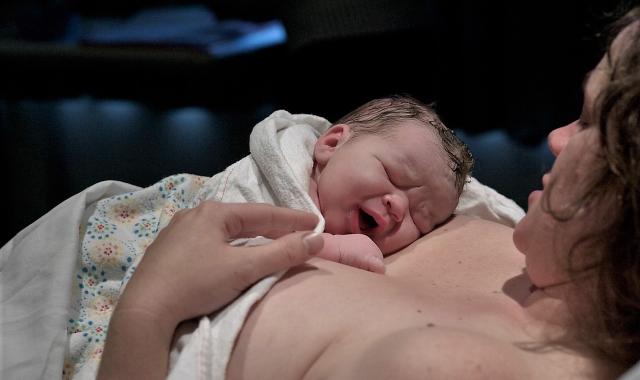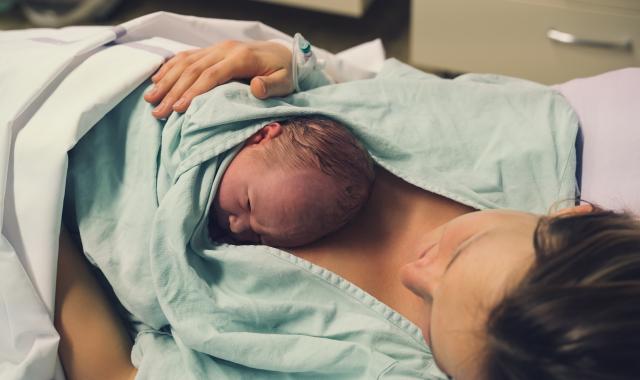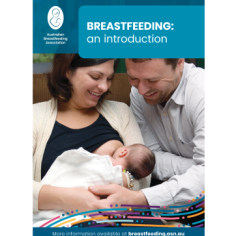The instinctive way to get your baby to attach and your milk to flow.

Your baby can be placed straight onto your bare chest right after birth. You can enjoy skin-to-skin contact until after the first breastfeed, or longer. Beyond that skin-to-skin contact can happen any time while you and your baby are learning to breastfeed or when your baby needs comforting or calming.
Skin-to-skin contact is important for all babies and mums.1,2,3 It is also a crucial part of ‘Kangaroo mother care’ for babies who are born early or small. Kangaroo mother care helps babies to grow and develop well.4 The World Health Organization recommend this type of care, along with exclusive breastfeeding, for all premature or low-birth-weight babies.5
Skin-to-skin contact is good for your baby
It helps regulate your baby’s heart rate, temperature and blood sugar levels.6
It helps to release hormones and trigger instincts in your baby that make feeding easier and more natural.1
It helps your baby to indicate to you when they are ready to feed.
Your baby is more likely to attach to your breast and attach well.7,8
If your baby is upset, placing them skin-to-skin on your chest can help calm them.
Skin-to-skin contact is good for you
It helps release the hormones that are important for making milk.1-3
It helps you to learn your baby's feeding cues.1-3
It helps you to bond with your baby.9
If you need to express for your baby, holding them skin-to-skin releases oxytocin which helps to release milk.10
Skin-to-skin for baby-led attachment
While you are both learning to breastfeed, starting with your baby skin-to-skin can help them to instinctively move and attach to your breast.1,7,8 You may like to undress baby, leaving them in just a nappy and remove your shirt and bra. Place a soft blanket over you both for warmth or privacy if needed.
Hold your baby against your body in a way that feels right for you. Many mothers find that leaning back with their baby on their chest between their breasts works best for them.
In these early days, keep your baby skin-to-skin on your chest as much as possible. This will allow them to start to feed whenever they are ready.
Skin-to-skin if you need to feel the love
Many mothers find that using skin-to-skin contact can improve their bond with their baby. Having your baby undressed and on your bare chest causes a release of hormones that make you feel good about your baby. Oxytocin decreases maternal anxiety, lessening the risk of post-partum depression.
Reclining back and holding your baby skin-to-skin can calm you when the stresses of motherhood seem overwhelming.
Planning for skin to skin
When you are preparing for the birth, talk with your caregivers about your desire to have your baby placed skin-to-skin on your chest directly after birth. Ask that your baby remain on your chest until after the first breastfeed. Checks and weighing can usually wait until after this.

Special situations
If you have a caesarean birth, either planned or emergency, ask that your baby is placed on your chest after birth. Many hospitals do this as standard practice. If you need medical care yourself and can't have your baby on your chest, they can still have skin-to-skin contact at that time with your partner.5,11,12
Skin-to-skin time between mum and baby is even more important for a premature baby or baby in special care. This contact, also called ‘kangaroo mother care’, helps to keep your baby’s heart rate, breathing rate and temperature steady, much more so than in a humidicrib. Skin-to-skin contact will also help to release the breastfeeding hormones in your body. This in turn will help build up your milk supply.
Kangaroo mother care is most helpful for babies if started immediately after birth. This may be in a healthcare facility or at home. The baby should be held on the mum's chest for as many hours a day as possible, ideally between 8 to 24 hours. A partner or other family member can provide this care if mum is not able to.5
Even if you and your baby weren’t able to be together immediately, you can have skin-to-skin contact at any time and it will still trigger your baby’s inborn feeding responses. Holding your baby as you prepare to feed will help you to notice their feeding cues and make it easier for them to move to your breast and attach well.
1. Moore, E. R., Bergman, N., Anderson, G. C., & Medley, N. (2016). Early skin-to-skin contact for mothers and their healthy newborn infants. The Cochrane Database of Systematic Reviews. https://doi.org/10.1002/14651858.CD003519.pub4
2. Crenshaw, J. T. (2014). Healthy birth practice #6: Keep mother and baby together—it’s best for mother, baby, and breastfeeding. The Journal of Perinatal Education, 23(4), 211–217.
3. McFadden, A., Gavine, A., Renfrew, M. J., Wade, A., Buchanan, P., Taylor, J. L., Veitch, E., Rennie, A. M., Crowther, S. A., Neiman, S., & MacGillivray, S. (2017). Support for healthy breastfeeding mothers with healthy term babies. Cochrane Database of Systematic Reviews.
https://doi.org/10.1002/14651858.CD001141.pub5
4. Wang, Y., Zhao, T., Zhang, Y., Li, S., & Cong, X. (2021). Positive effects of kangaroo mother care on longterm breastfeeding rates, growth, and neurodevelopment in preterm infants. Breastfeeding Medicine, 16(4), 282–291.
5. World Health Organization. (2022). WHO recommendations for care of the preterm or low birth weight infant. Licence: CC BY-NC-SA 3.0 IGO. https://www.who.int/publications/i/item/9789240058262
6. Bergman, N. J., Linley, L. L., & Fawcus, S. R. (2004). Randomized controlled trial of skin-to-skin contact from birth versus conventional incubator for physiological stabilization in 1200- to 2199-gram newborns. Acta Paediatrica, 93(6), 779–785.
7. Stevens, J., Schmied, V., Burns, E., & Dahlen, H. (2014). Immediate or early skin-to-skin contact after a caesarean section: A review of the literature. Maternal & Child Nutrition, 10(4), 456–473.
8. Li, Z., Mannava, P., Murray, J., Sobel, H. L., Jatobatu, A., Calibo, A., Tsevelmaa, B., Saysanasongkham, B., Ogaoga, D., Waramin, E. J., Mason, E. M., Obara, H., Tran, H. T., Tuan, H. A., Kitong, J., Yaipupu, J. M., Cheang, K., Silvestre, M. A., Kounnavongsa, O., Putney, P., … Western Pacific Region Early Essential Newborn Care
Working Group (2020). Association between early essential newborn care and breastfeeding outcomes in eight countries in Asia and the Pacific: A cross-sectional observational study. BMJ Global Health, 5(8),
e002581.
9. Kennell, J., & McGrath, S. (2005). Starting the process of mother–infant bonding. Acta Paediatrica, 94(6), 775–777.
10. Jurek, B., & Neumann, I. D. (2018). The oxytocin receptor: From intracellular signaling to behavior. Physiological Reviews, 98(3), 1805–1908.
11. Baley, J., & Committee on Fetus and Newborn. (2015). Skin-to-skin care for term and preterm infants in the neonatal ICU. Pediatrics, 136(3), 596–599.
12. Erlandsson, K., Dsilna, A., Fagerberg, I., & Christensson, K. (2007). Skin-to-skin care with the father after cesarean birth and its effect on newborn crying and prefeeding behavior. Birth, 34(2), 105–114.
© Australian Breastfeeding Association March 2023
Learn more about getting breastfeeding started
Your guide for navigating the first 72 hours with your newborn. Free for Virtual Village members.
The first 72 hours - eModule

Online interactive session free for Virtual Village members
Newborn Virtual Village - Comfortable attachment

Evidence-led info and practical tips from our Breastfeeding Information Series
Breastfeeding: an introduction




